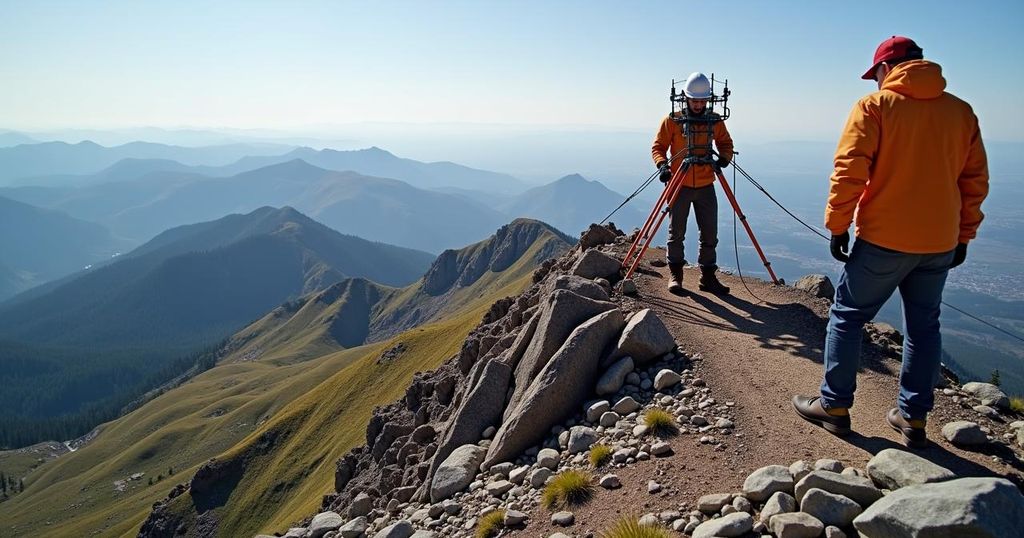Enhanced Monitoring Efforts at Mount Adams Following Surge in Seismic Activity

Scientists have initiated the installation of new monitoring equipment around Mount Adams, Washington’s largest active volcano, in response to an unusual increase in seismic activity. Six earthquakes were recorded in September 2024, marking a notable rise from typical activity levels. Researchers are enhancing their monitoring capabilities by adding temporary sensors to gather more comprehensive data. Jon Major from the USGS has stated that there is no cause for immediate concern regarding volcanic activity, although the situation is under close observation.
In response to a notable increase in seismic activity, scientists have commenced the installation of advanced monitoring equipment around Mount Adams, recognized as Washington’s largest active volcano. This surge in earthquake occurrences has raised significant concerns and prompted researchers to enhance their observational capabilities. Typically, Mount Adams experiences seismic events at intervals of every two to three years; however, in September 2024, a total of six earthquakes were documented—representing the highest monthly tally since monitoring began in 1982. This unusual escalation in seismic activity has necessitated proactive measures by the scientific community. At present, there exists only one permanent seismic monitor situated approximately six-and-a-half miles from the volcano. To bolster monitoring efforts, scientists are in the process of deploying additional temporary sensors in the vicinity. The newly established monitoring stations will capture seismic vibrations, thus furnishing researchers with more detailed data regarding the phenomena occurring beneath the volcano. “Right now, there’s only one monitor within about six-and-a-half miles of the volcano. With only one monitor, it’s very hard to do really good locations. It’s really difficult to get accurate depth of the earthquakes,” stated Jon Major, Scientist-in-Charge at the USGS Cascades Volcano Observatory. Despite the palpable increase in seismic activity, Major reassured the public, asserting that there exists no immediate cause for alarm. “At the current time, there’s no cause for concern. We’re keeping what we call our alert-level status at ‘normal.’ There’s a good chance this is just background activity at the volcano,” he noted. Mount Adams, located in south-central Washington approximately thirty miles north of the White Salmon-Hood River area, is classified as a “High Risk” volcano by the United States Geological Survey (USGS). While the recent rise in seismic events is under close scrutiny, Major emphasized that there is currently no evidence to suggest an impending eruption. As the installation of new sensors progresses, scientists will be equipped to gather a more comprehensive dataset, thus enhancing their understanding and assessment of the volcanic activity. This ongoing research is intended to improve safety measures and preparedness for surrounding communities, while continuously monitoring the geological behavior of this active volcano.
Mount Adams is a prominent volcano located in Washington State, classified as a potentially dangerous geological feature due to its status as an active volcano. Typically, the seismic activity associated with this volcano is minimal, occurring every few years. However, recent events have indicated a significant increase in seismic occurrences, prompting enhanced monitoring efforts by scientists to assess the situation more effectively. Understanding the behavior of such volcanoes is crucial for ensuring public safety and for furthering scientific knowledge in volcanology.
In summary, scientists are actively enhancing their monitoring systems around Mount Adams due to an unexpected rise in seismic activity. While the recent uptick raises concerns, experts maintain that there is no immediate threat of an eruption. The deployment of additional sensors aims to provide better data and improve overall preparedness for the surrounding communities. Continuous efforts in researching and understanding volcanic activity remain paramount for the safety and well-being of those living near such geological features.
Original Source: seattlemedium.com







